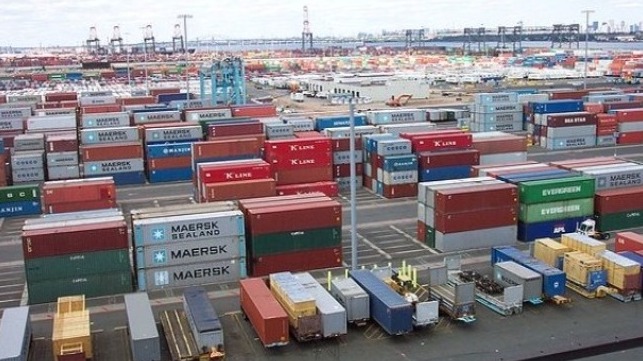Xeneta: Container Rates Remain High, but Increases are Slowing

After numerous reports of the rapid rise in long-term contracted freight rates to record levels, there may be some signs of a slowing in the increases - but no relief for the financially battered shipper community. Market intelligence platform Xeneta reports that it recorded an easing in the rate of increase according to its Long-Term XSI Public Indices.
According to data from Xeneta, the mean for long-term contracted ocean freight rates is up over 37 percent in 2021 and a staggering 39 percent year-over-year. Rate increases accelerated this year surging ahead nine percent in May. However, the latest figures show an easing in the rate of increase to 2.3 percent in June, but Xeneta says there appears to be little relief on the horizon.
“We have witnessed truly astronomical increases, due to a very complex combination of factors – from the way coronavirus has both disrupted supply and driven demand, through to unforeseen events, such as the blockage of the Suez Canal,” comments Xeneta CEO Patrik Berglund. “All the time the carriers have managed routes and capacity to maintain a position of unparalleled strength in negotiations. It is, without doubt, a difficult time to be a shipper.”
Xeneta says seen in the context of 2021, a 2.3 increase gain in June appears only moderate, but in any other month, in any other year, it would have been seen as a very strong performance for the carriers.
Berglund predicts that there’s little relief in sight. Carriers, Xeneta notes are making bold moves to increase their fleets, but, for the most part, these are long-term decisions rather than short-term capacity injections. They pointed to the record containership orderbook, with for example, HMM ordering twelve 13,000 TEU vessels for $1.57 billion, which will take the capacity of the Korean line past one million slots, while Hapag-Lloyd has ordered six 23,500 TEU ships, with delivery expected from 2024.
In the meantime, the supply chain is buckling under pressure. As Berglund explains, “Ports in the U.S. are facing new levels of congestion, causing huge delays in shipments and inventory shortages for retailers. In fact, a recent survey by the National Retail Federation (NRF) found that 97 percent of members had been impacted by port and shipping delays, while President Biden has announced the creation of a Supply Chain Disruptions Task Force. Looking further afield, let’s not forget Yantian and Shenzhen, which were hit by COVID a couple of weeks ago making it even more difficult to balance supply and demand.”
In a connected industry, the ripple effects of disruption are everywhere, says Xeneta. In Europe, they pointed to vessels from Asia being delayed by up to three weeks, while some carriers are now omitting selected port calls all together. The 2M alliance recently announced it would not be stopping at Rotterdam on its Asia-North Europe loops for the next seven weeks, with THE Alliance following suit. Maersk and MSC, meanwhile, are skipping Hamburg on their AE7/Condor loop for another four weeks due to ongoing congestion.
The result according to Xeneta is that shippers are left with the unpalatable combination of deteriorating reliability and climbing spot and contract rates. It’s exceptionally tough for shippers to navigate the market right now, as the delta between short and contract rates continues to grow. Carriers unquestionably have the upper hand and are in a strong position to exploit the budgets of big volume shippers.
“We should all brace ourselves for the carriers’ and forwarders’ Q2 financials,” says Berglund. “It will be a joyful moment for the sellers, but painful for the rest of the market. However, it’s universally positive that it gives the seller community an opportunity to invest those gains in more sustainable, eco-friendly infrastructure. We hope they seize it.”
The XSI index is drawn from over 280 million data points, with more than 160,000 port-to-port pairings, demonstrating a month of overall rates increases, with one or two regional exceptions, says Xeneta. In Europe, imports declined for the first time in seven months, with a 4.2 percent fall. However, the index remains a breathtaking 48.1 percent up year-on-year. Exports rose 1.9 percent and stand 18.1 percent higher than June 2020.

that matters most
Get the latest maritime news delivered to your inbox daily.
The Far East import benchmark climbed by 1.5 percent, up 27.3 percent year-on-year, with exports also gaining, edging up a further 2 percent to 67.8 percent above this time last year. It was a tale of two indices in the U.S., with imports surging 9.3 percent in June (36.9 percent up year-on-year), while exports fell 2 percent. Xeneta highlights that this is the only index down against June 2020, with a drop of 2.1 percent (although it has risen 6.6 percent in 2021).
“It’ll be fascinating to see what comes next,” concludes Berglund. “The key question is how do shippers try and regain a sense of control. We’ve already seen the arrival of CULines, supported by purchasing association XSTAFF, as an alternative solution, and June saw the news that Home Depot in the U.S. was making the audacious move of chartering its own vessel to secure a more stable, predictable supply chain. Not everyone is in a position to do this, of course, but it’s a very interesting development as shippers desperately seek some short-term relief.”
